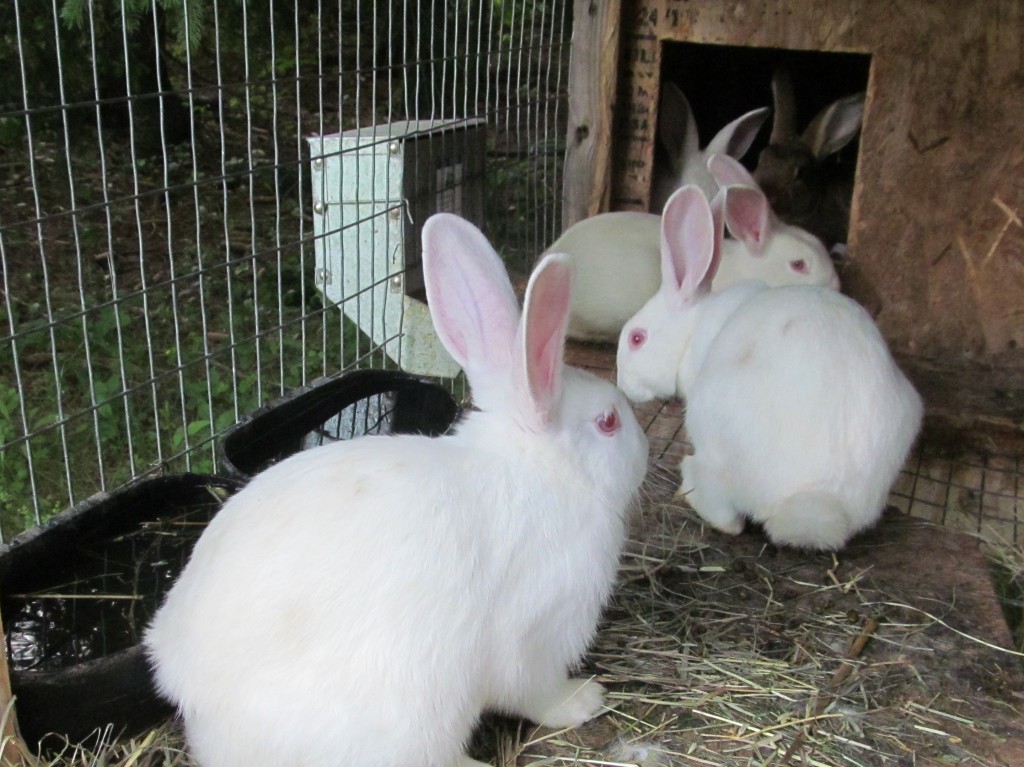Raising rabbits for meat can be very fun and rewarding. In my perusing of articles on rabbits, I ran across someone that described it as “pulling food out of a hat.” In this article I will mainly discuss raising rabbits for home and family consumption, but there may be business opportunities as well depending on your location and resources. In an earlier article I discussed the importance of selecting the right breed for your homestead or farm. Now that you have the rabbits, what do you feed them?
Feeding and nutrition is very important for any livestock and rabbits are no different. With our modern technology, feeding rabbits has really become a simple process. Pellets are available commercially that are a complete feed and eliminate any need to provide extra vitamins, minerals, salt, etc. These feeds are typically 16-18% protein and are good for all life stages, but you may need to limit feed older or non-productive animals to prevent them from gaining excess weight. Growing animals and lactating does can be free fed. Since my personal rabbits are housed outside year round, I also give them additional feed during cold months. As with any animal, water is essential. This is especially true in warmer months. Rabbits are more suited to deal with cold rather than warm weather and care always needs to be taken to keep rabbits cool. I lost 7 out of 8 kits in a litter on one hot day. Since then, I moved all of the hutches under some large trees to provide additional cooling and have not (knock on wood!) had any problems.
It is also generally recommended and appreciated by rabbits if you supply them with hay. The pelleted feed is complete, but high quality hay can supplement the diet as well. Just remember when purchasing hay, you get what you pay for! You may think you are saving money with that $2.00 bale of hay, but are you? If you are buying hay that is stemmy, dusty or full of weeds you are not providing the correct nutrition to your growing animals. You can also supplement with fruits and vegetables, but people have mixed success with this. Proceed with caution to make sure none of your animals are getting diarrhea. Providing correct nutrition for maximum growth is important for rabbits especially, because they begin mating and fighting with each other at about 12 weeks. This is also the time that many people butcher their animals. If you are not feeding your animals correctly, they may not be an adequate size by this time and it could force you to find individual housing until they reach the desired size. This is difficult when you have litters of 8-10!
Proper nutrition can allow the animals to reach their genetic potential, helps maintain health, and you may be able to harvest your animals even earlier than 12 weeks of age. Be aware though, overweight animals can be a problem as well. Bucks can become lazy and not interested in mating and does can have a difficult time conceiving and kindling (birthing) due to internal fat. Rabbits are naturally most active in the evening and night and this makes it a great time to feed them. The general feeding recommendation is 1 oz. feed per pound of body weight, so a 4 pound rabbit would get 4 oz. of pellets (except lactating does and growing fryers, which are free fed).
Overall, rabbit feeding is fairly straightforward. A high quality commercial pellet along with some good alfalfa or nice grass hay should be all you need. As with any animal, make sure there is always water available, especially in warm summer months. There is an old saying, “the best fertilizer is the feet of the farmer.” I think this applies to our livestock as well. Take some time to observe your animals, weigh them, take notice of their conformation and growth, and any other parameters that are important to you. Just always remember, we are doing this to provide a high quality source of food for ourselves, families, and friends, while also providing a high welfare environment and quality of life for the animal. If you keep those things in mind when you are making decisions, you can’t go wrong. If you have any questions you can contact me anytime at arp253@cornell.edu or (518) 272-4210.
Additional Information and Sources:


